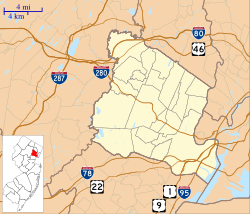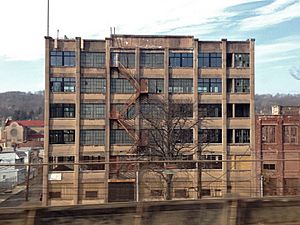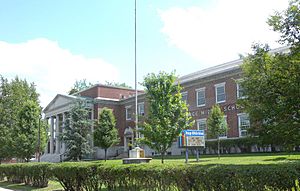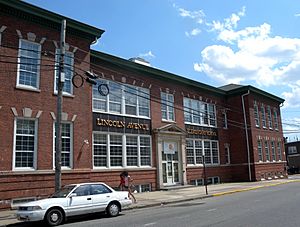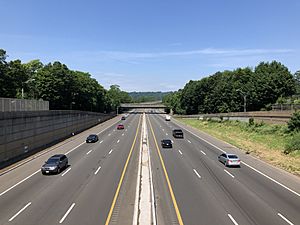Orange, New Jersey facts for kids
Quick facts for kids
Orange, New Jersey
|
||
|---|---|---|
|
Township
|
||
| City of Orange Township | ||
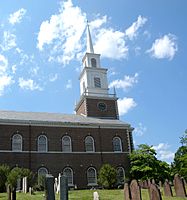
The former First Presbyterian Church
|
||
|
||
| Country | ||
| State | ||
| County | Essex | |
| Incorporated | November 27, 1806 (as township) | |
| Reincorporated | April 3, 1872 (as city) | |
| Government | ||
| • Type | Faulkner Act Mayor-Council | |
| • Body | City Council | |
| Area | ||
| • Total | 2.22 sq mi (5.74 km2) | |
| • Land | 2.21 sq mi (5.73 km2) | |
| • Water | <0.01 sq mi (0.01 km2) 0.09% | |
| Area rank | 392nd of 565 in state 19th of 22 in county |
|
| Elevation | 197 ft (60 m) | |
| Population
(2020)
|
||
| • Total | 34,447 | |
| • Estimate
(2023)
|
33,787 | |
| • Rank | 69th of 565 in state 8th of 22 in county |
|
| • Density | 15,565.7/sq mi (6,010.0/km2) | |
| • Density rank | 17th of 565 in state 3rd of 22 in county |
|
| Time zone | UTC−05:00 (Eastern (EST)) | |
| • Summer (DST) | UTC−04:00 (Eastern (EDT)) | |
| ZIP Codes |
07050–07051
|
|
| Area code(s) | 973 | |
| FIPS code | {{{1}}}-{{{2}}} | |
| GNIS feature ID | 1729742 | |
The City of Orange (known simply as Orange) is a township in Essex County, in the U.S. state of New Jersey. As of the 2020 United States census, the township's population was 34,447, an increase of 4,313 (+14.3%) from the 2010 census count of 30,134, which in turn reflected a decline of 2,734 (-8.3%) from the 32,868 counted in the 2000 census.
The New Jersey Legislature originally incorporated Orange as a township on November 27, 1806, from parts of Newark Township. Parts of the township were taken on April 14, 1834, to form the now-defunct Clinton Township. On January 31, 1860, Orange was reincorporated as a town. Parts of the town were taken to form South Orange Township (April 1, 1861, now known as Maplewood), Fairmount (March 11, 1862, now part of West Orange), East Orange Township (March 4, 1863) and West Orange Township (April 10, 1863). On April 3, 1872, Orange was reincorporated as a city. In 1982, the city was one of four Essex County municipalities to pass a referendum to become a township, joining 11 municipalities that had already made the change, of what ultimately were more than a dozen Essex County municipalities to reclassify themselves as townships to take advantage of federal revenue sharing policies that allocated townships a greater share of government aid to municipalities on a per capita basis. The city derives its name from William III of England or William IV, Prince of Orange.
Despite the differences in the municipalities' character, Orange, East Orange, South Orange and West Orange are sometimes jointly called The Oranges.
In 2020, the township had New Jersey's 12th-highest property tax rate, with an equalized rate of 4.679% compared to 2.824% in the county as a whole and a statewide average of 2.279%.
Contents
History
Orange has its origins in Connecticut's New Haven Colony. In 1666, 30 of New Haven's families traveled by water to found "a town on the Passayak" River. They arrived on territory now encompassing Newark, the Oranges, and several other municipalities. The area was in the northeast portion of a land grant conveyed by King Charles II of England to his brother James, Duke of York. In 1664, James conveyed the land to two proprietors, Lord John Berkeley and Sir George Carteret. Since Carteret had been Royal Governor of the Isle of Jersey, the territory became known as "New Jersey."
Orange was initially part of the city of Newark, but it was originally known as "Newark Mountains". On June 7, 1780, the townspeople of Newark Mountains officially voted to adopt the name Orange. At the time, a significant number of people favored secession from Newark. This did not occur until November 27, 1806, when the territory now encompassing all of the Oranges was finally detached.
On April 13, 1807, the first government was elected, but not until March 13, 1860, was Orange officially incorporated as a city. Immediately, the new city began fragmenting into smaller communities, primarily because of local disputes about the costs of establishing paid police, fire, and street departments. South Orange was organized on January 26, 1861; Fairmount (later to become part of West Orange) on March 11, 1862; East Orange on March 4, 1863; and West Orange (including Fairmount) on March 14, 1863.
Early center of transportation
Orange is on the Newark and Mount-Pleasant Turnpike, the main road from Newark to Morristown, and ultimately to Easton, Pennsylvania. The town became a busy thoroughfare for travelers, and hotels abounded. Initially, the stagecoach was the primary method of transportation. Omnibuses of the Eclipse and the Morris & Newark Lines serviced Orange.
The Morris and Essex Railroad arrived in Orange in November 1836, its first cars drawn by horses. On October 2, 1837, the first steam locomotive appeared, and the horses were, with minor exception, relegated to pasture. The "M&E" later became a part of the Delaware, Lackawanna and Western Railroad (DL&W), which exists today as NJ Transit's Morristown Line.
Trolley cars appeared much later, with the Orange and Newark Horse Car Railroad Company running its first car up Main Street in May 1862. The Orange Crosstown Line, eventually extending from Morris Street, Orange, to Bloomfield, was started in June 1888. (The first electric trolley in the State of New Jersey operated over a section of this line.) Eventually, all the trolleys, and the buses that replaced them, became part of the sprawling Public Service Coordinated Transport System.
Orange became an industrial city early in its history, with the tanning industry expanding rapidly after settlers found growths of hemlock trees that were a source for the tannic acid they needed, leading to the growth of many factories producing shoes and boots.
Orange was once the United States' hat-making capital. The industry can be traced there to 1792. By 1892, 21 firms were engaged in that trade, employing over 3,700 people in plants that produced about 4.8 million hats, which had a combined value in excess of $1 million (equivalent to $32.6 million in 2022). Several brothers founded the "No-Name Hat Company" in Orange before one of them moved on to make fedoras in Philadelphia under the family name, "Stetson." By 1921, only five hat-making firms were left, many having departed for places such as Norwalk and Danbury, Connecticut. By 1960, all had left.
Beer was a major industry in Orange beginning in the early 1900s, when the three Winter Brothers of Pittsburgh, Pennsylvania, arrived in the city and built the first brewery. The Orange Brewery was constructed in 1901 at a reported cost of $350,000 (equivalent to $12.3 million in 2022). The production of beer ceased with prohibition in 1920, and after the repeal of the Volstead Act in 1933, the brewery was sold to John F. Trommers of Philadelphia. Trommers brewed beer under that label until 1950, when the concern was again sold to Liebmann Breweries, Incorporated, which bottled Rheingold Beer. Eventually, after passing through several other owners, the plant was closed permanently in 1977.
Other notable firms in Orange were the Monroe Calculating Company, manufacturers of the adding machines of the same name, and the Bates Manufacturing Company, producers of office accessories such as staplers and stampers.
The United States Radium Corporation refined ore and extracted the radium used to make luminous paint for dials and hands of watches and other indicators. Years later, the carcinogenic effects of this material became known, and the polluted site of the factory became a liability for the city.
Famous residents and visitors
Orange has produced such notables as baseball's Monte Irvin and heavyweight boxer Tony Galento. Actor William Bendix lived and worked here for a short while. Presidents, presidential candidates, and governors visited. Orange held major celebrations for its 100th anniversary, and another when it turned 150.
Geography
According to the United States Census Bureau, the township had a total area of 2.22 square miles (5.74 km2), including 2.21 square miles (5.73 km2) of land and <0.01 square miles (0.01 km2) of water (0.09%).
The East Branch of the Rahway River travels through Orange.
Orange borders the Essex County municipalities of East Orange, Glen Ridge, Montclair, South Orange and West Orange.
Demographics
| Historical population | |||
|---|---|---|---|
| Census | Pop. | %± | |
| 1810 | 2,266 | — | |
| 1820 | 2,830 | 24.9% | |
| 1830 | 3,887 | 37.3% | |
| 1840 | 3,264 | * | −16.0% |
| 1850 | 4,385 | 34.3% | |
| 1860 | 8,877 | 102.4% | |
| 1870 | 9,348 | * | 5.3% |
| 1880 | 13,207 | 41.3% | |
| 1890 | 18,844 | 42.7% | |
| 1900 | 24,141 | 28.1% | |
| 1910 | 29,630 | 22.7% | |
| 1920 | 33,268 | 12.3% | |
| 1930 | 35,399 | 6.4% | |
| 1940 | 35,717 | 0.9% | |
| 1950 | 38,037 | 6.5% | |
| 1960 | 35,789 | −5.9% | |
| 1970 | 32,566 | −9.0% | |
| 1980 | 31,136 | −4.4% | |
| 1990 | 29,925 | −3.9% | |
| 2000 | 32,868 | 9.8% | |
| 2010 | 30,134 | −8.3% | |
| 2020 | 34,447 | 14.3% | |
| 2023 (est.) | 33,787 | 12.1% | |
| Population sources: 1810–1920 1840–1900 1840 1850–1870 1850 1870 1880–1890 1890–1910 1860–1930 1940–2000 2000 2010 2020 * = Lost territory in previous decade. |
|||
2020 census
| Race / Ethnicity (NH = Non-Hispanic) | Pop 2000 | Pop 2010 | Pop 2020 | % 2000 | % 2010 | % 2020 |
|---|---|---|---|---|---|---|
| White alone (NH) | 2,502 | 1,357 | 1,073 | 7.61% | 4.50% | 3.11% |
| Black or African American alone (NH) | 24,318 | 21,067 | 21,627 | 73.99% | 69.91% | 62.78% |
| Native American or Alaska Native alone (NH) | 79 | 114 | 44 | 0.24% | 0.38% | 0.13% |
| Asian alone (NH) | 414 | 448 | 262 | 1.26% | 1.49% | 0.76% |
| Pacific Islander alone (NH) | 17 | 3 | 7 | 0.05% | 0.01% | 0.02% |
| Some Other Race alone (NH) | 168 | 169 | 303 | 0.51% | 0.56% | 0.88% |
| Mixed Race or Multi-Racial (NH) | 1,273 | 445 | 1,148 | 3.87% | 1.48% | 3.33% |
| Hispanic or Latino (any race) | 4,097 | 6,531 | 9,983 | 12.47% | 21.67% | 28.98% |
| Total | 32,868 | 30,134 | 34,447 | 100.00% | 100.00% | 100.00% |
2010 census
The 2010 United States census counted 30,134 people, 11,202 households, and 6,878 families in the township. The population density was 13,705.7 per square mile (5,291.8/km2). There were 12,222 housing units at an average density of 5,558.9 per square mile (2,146.3/km2). The racial makeup was 12.80% (3,857) White, 71.83% (21,645) Black or African American, 0.57% (173) Native American, 1.51% (455) Asian, 0.02% (6) Pacific Islander, 9.95% (2,999) from other races, and 3.32% (999) from two or more races. Hispanic or Latino of any race were 21.67% (6,531) of the population.
Of the 11,202 households, 31.0% had children under the age of 18; 28.6% were married couples living together; 24.6% had a female householder with no husband present and 38.6% were non-families. Of all households, 32.7% were made up of individuals and 11.4% had someone living alone who was 65 years of age or older. The average household size was 2.66 and the average family size was 3.38.
25.0% of the population were under the age of 18, 9.8% from 18 to 24, 30.5% from 25 to 44, 23.6% from 45 to 64, and 11.2% who were 65 years of age or older. The median age was 34.4 years. For every 100 females, the population had 89.0 males. For every 100 females ages 18 and older there were 84.1 males.
The Census Bureau's 2006–2010 American Community Survey showed that (in 2010 inflation-adjusted dollars) median household income was $40,818 (with a margin of error of +/− $1,616) and the median family income was $44,645 (+/− $4,033). Males had a median income of $34,986 (+/− $3,168) versus $36,210 (+/− $2,706) for females. The per capita income for the borough was $19,816 (+/− $1,027). About 16.2% of families and 18.1% of the population were below the poverty line, including 24.6% of those under age 18 and 20.6% of those age 65 or over.
Emergency services
Fire department
The City of Orange is served by the professional firefighters of the city of Orange Fire Department (OFD). Founded in 1872, the OFD operates out of two fire stations, located at 419 Central Avenue and 257 Washington Street. The firefighting apparatus consists of two fire engines, two quints and a ladder truck.
Education
The Orange Board of Education serves public school students in pre-kindergarten through twelfth grade. The district is one of 31 former Abbott districts statewide that were established pursuant to the decision by the New Jersey Supreme Court in Abbott v. Burke which are now referred to as "SDA Districts" based on the requirement for the state to cover all costs for school building and renovation projects in these districts under the supervision of the New Jersey Schools Development Authority.
As of the 2020–21 school year, the district, comprised of 12 schools, had an enrollment of 5,629 students and 507.5 classroom teachers (on an FTE basis), for a student–teacher ratio of 11.1:1. Schools in the district (with 2020–21 enrollment data from the National Center for Education Statistics) are Orange Early Childhood Center (188 students; in Pre-K), John Robert Lewis Early Childhood Center (NA; Pre-K), Central Elementary School (319; K–2), Cleveland Street School (303; K–7), Forest Street Community School (410; Pre-K–7), Heywood Avenue School (355; Pre-K–7), Lincoln Avenue School (708; K–7), Oakwood Avenue Community School (425; Pre-K–7), Park Avenue School (569; K–7), Rosa Parks Central Community School (999; Grades 3–7; formerly Main Street School and Central School), Scholars Academy (NA), Orange Preparatory Academy (679; 8–9, formerly Orange Middle School), Orange High School (840; 10–12) and STEM Innovation Academy of the Oranges (160; 9–12).
The Orange Public Library collection contains 200,000 volumes and circulates 43,000 items annually. Built as the Stickler Memorial Library, the imposing structure designed by McKim, Mead, and White opened in 1901.
Economy
Portions of the city are part of an Urban Enterprise Zone (UEZ), one of 32 zones covering 37 municipalities statewide. Orange was selected in 1983 as one of the initial group of 10 zones chosen to participate in the program. In addition to other benefits to encourage employment and investment within the Zone, shoppers can take advantage of a reduced 3.3125% sales tax rate (half of the 6+5⁄8% rate charged statewide) at eligible merchants. Established in November 1992, the city's Urban Enterprise Zone status expires in November 2023.
Transportation
Roads and highways
As of May 2010[update], the city had a total of 44.64 miles (71.84 km) of roadways, of which 39.14 miles (62.99 km) were maintained by the municipality, 4.43 miles (7.13 km) by Essex County and 1.07 miles (1.72 km) by the New Jersey Department of Transportation.
Interstate 280 is the most significant highway serving the city, traversing along an east-west alignment from the border with West Orange to the East Orange city line. The only other significant roadway serving Orange is County Route 508, which follows Central Avenue. Principal local roads include Valley Street, Lincoln Avenue, Scotland Road and Highland Avenue.
Public transportation
The Orange and Highland Avenue stations provide NJ Transit train service along the Morris & Essex Lines (formerly Erie Lackawanna Railway). Service is available via the Kearny Connection to Secaucus Junction and Penn Station in Midtown Manhattan and to Hoboken Terminal. Passengers can transfer at Newark Broad Street or Summit station to reach the other destination if necessary.
NJ Transit buses in Orange include the 21, 24, 34, 41, 44, 71, 73 and 79 routes providing service to Newark and local service on the 92 and 97 routes.
Notable people
People who were born in, residents of, or otherwise closely associated with Orange include:
- Anthony Accetturo (born 1938), former caporegime and leader of the New Jersey faction of the Lucchese crime family, The Jersey Crew
- Robert Adams (born 1937), photographer who has focused on the changing landscape of the American West
- Walter G. Alexander (1880–1953), first African American member of the New Jersey Legislature
- Jay Alford (born 1983), defensive tackle for the Oakland Raiders drafted in the third round of the 2007 NFL draft (81st overall)
- Peter Allgeier, served as U.S. Deputy Trade Representative from May 2001 until August 2009
- George Armstrong (1924–1993), catcher who played eight MLB games in 1946 with the Philadelphia Athletics
- Tom Auth (born 1968), rower who competed at the 1996 Summer Olympics and the 2000 Summer Olympics
- Bobby Bandiera (born 1953), rock guitarist, singer and songwriter who was lead guitarist for Southside Johnny and the Asbury Jukes
- James J. Barry Jr. (born 1946), politician who served in the New Jersey General Assembly and as Director of the New Jersey Division of Consumer Affairs
- Stephen J. Benkovic (born 1938), chemist
- Douglas J. Bennet (1938–2018), political official who served as the fifteenth president of Wesleyan University
- John L. Blake (1831–1899), represented New Jersey's 6th congressional district from 1879 to 1881
- Ken Blanchard (born 1939), author, whose works include The One Minute Manager
- Thomas Aloysius Boland (1896–1979), prelate of the Roman Catholic Church who was Archbishop of Newark from 1952 to 1974
- Cory Boyd (born 1985), former starting tailback for the University of South Carolina and drafted by the Tampa Bay Buccaneers in the 7th round (238th pick overall) of the 2008 NFL draft
- Sandra Boynton (born 1953), humorist, songwriter, director, music producer, children's author and illustrator
- Garrett Brown Jr. (born 1943), former United States District Judge and later the Chief Judge of the United States District Court for the District of New Jersey
- Lesley Bush (born 1947), diver who represented the United States at the 1964 Summer Olympics in Tokyo, where she received a gold medal in platform diving
- Samuel P. Bush (1863–1948), industrialist and patriarch of the Bush political family
- Bisa Butler (born 1973), fiber artist known for her quilted portraits and designs celebrating black life
- Peter Cain (1959–1997), artist who is best known for his meticulously executed paintings and drawings of surreal and aberrant versions of automobiles
- Ernest Trow Carter (1866–1953), organist and composer who won the Bispham Award
- Herbert S. Carter (1869–1927), physician and writer
- Dennis M. Cavanaugh (born 1947), retired United States district judge of the United States District Court for the District of New Jersey
- Robert Hett Chapman (1771–1833), Presbyterian minister and missionary and the second president of the University of North Carolina at Chapel Hill
- Evans Clark (1888–1970), writer strongly committed to first to Communist and Socialist causes and then liberal socio-economic issues
- Harold L. Colburn Jr. (1925–2012), physician and politician who served in the New Jersey General Assembly representing the 8th Legislative District from 1984 to 1995
- Richard Codey (born 1946), politician who served in the New Jersey Legislature since 1974 and was the 53rd Governor of New Jersey, from 2004 to 2006
- Steven A. Cohen (born 1953), academic who has taught public management and environmental policy at Columbia University since 1981
- Corinne Alsop Cole (1886–1971), politician who served two terms as a member of the Connecticut House of Representatives
- Samuel Colgate (1822–1897), manufacturer and philanthropist, who headed the soap company that is now part of Colgate-Palmolive and was a benefactor of Colgate University
- John Condit (1755–1834), United States Representative and Senator from New Jersey
- Silas Condit (1778–1861), represented New Jersey in the United States House of Representatives from 1831 to 1833
- Peter Cortes (born 1947), rower who competed in the men's quadruple sculls event at the 1976 Summer Olympics
- Bob Cottingham (born 1966), Olympic fencer who competed in the sabre events at the 1988 and 1992 Summer Olympics
- John Crotty (born 1969), former NBA basketball player for the Cleveland Cavaliers, Portland Trail Blazers and Denver Nuggets
- Bobby Czyz (born 1962), champion prizefighter
- Brian E. Daley (born 1940), professor of theology who received the Ratzinger Prize in 2012
- Pete D'Alonzo (1929–2001), football player who played two seasons with the Detroit Lions of the NFL
- Constance Adams DeMille (1874–1960), actress and wife of director Cecil B. DeMille
- Wayne Dickens, former American football player and coach who was head football coach at Kentucky State University from 2009 to 2012 and The College of New Jersey from 2013 to 2015
- S. Kip Farrington (1904–1983), sport fisherman and journalist
- David Ferry (1924–2023), poet and translator who won the National Book Award for Poetry in 2012
- Dale S. Fischer (born 1951), United States district court judge
- Gail Fisher (1935–2000), actress best known for her role on Mannix
- Buddy Fortunato (born 1946), newspaper publisher and politician who served four terms in the New Jersey General Assembly
- Charles N. Fowler (1852–1932), represented 5th congressional district in the United States House of Representatives from 1895 to 1911
- Tony Galento (1910–1979), heavyweight boxer
- Robert E. Grady (born 1959), venture capitalist and investment banker
- Al Harrington (born 1980), professional basketball player for the NBA's Denver Nuggets, Golden State Warriors and Washington Wizards
- Edward V. Hartford (1870–1922), founder and President of the Hartford Suspension Company who perfected the automobile shock absorber
- George Huntington Hartford (1833–1917), Mayor from 1878 to 1890 and owner of the Great Atlantic and Pacific Tea Company, the country's largest food retailer at the time of his death
- Beatrice Hicks (1919–1979), founder of the Society of Women Engineers in 1950
- Cleo Hill (1938–2015), professional basketball player who played one season in the NBA for the St. Louis Hawks
- Dulé Hill (born 1975), actor, known for starring in TV series Psych and The West Wing
- Monte Irvin (1919–2016), former Negro leagues and MLB outfielder, MLB executive and member of the Baseball Hall of Fame
- Bobby M. Jones (born 1972), pitcher who played for the New York Mets during his MLB career
- Mark Kelly (born 1964), astronaut who first went into space as the pilot for STS-108 Endeavour (December 5–17, 2001), and returned to space with STS-121 in 2006 as the pilot; His twin brother, Scott Kelly, is also in the Astronaut Corps
- Thomas Kiernan (1933-2003), writer who was the author of a biographies that featured figures including Laurence Olivier, Jane Fonda, John Steinbeck, and Yasser Arafat.
- Jay Lynch (1945–2017), cartoonist best known for his comic strip Nard n' Pat
- Phyllis Mangina (born 1959), college basketball coach who is currently an assistant women's basketball coach at Saint Peter's
- William F. Marsh (1916–1995), politician who served in the California State Assembly for the 42nd district from 1953 to 1959
- John B. Mason (1858–1919), stage actor
- Lowell Mason (1792–1872), composer of over 1600 hymn tunes, including his arrangement of "Joy to the World"
- Elmer Matthews (1927–2015), lawyer and politician who served three terms in the New Jersey General Assembly
- George McClellan (1826–1885), American Civil War general and later Governor of New Jersey, died here
- Donald W. McGowan (1899–1967), United States Army Major General and Chief of the National Guard Bureau
- James T. McHugh (1932–2000), prelate of the Roman Catholic Church who served as Bishop of Camden (1989–1998) and Bishop of Rockville Centre (2000)
- John Milnor (born 1931), mathematician known for his work in differential topology, K-theory and dynamical systems and recipient of the Fields Medal, Wolf Prize, and Abel Prize
- Daniel F. Minahan (1877–1947), served as mayor of Orange from May 1914 until August 1919, and represented New Jersey's 6th congressional district from 1919 to 1921 and again from 1923 to 1925
- Tina Nenoff (born 1965), materials scientist and chemical engineer at Sandia National Laboratories
- Gordon Allen Newkirk Jr. (1928–1985), astrophysicist best known for his research on the solar corona
- Yosh Nijman (born 1995), American football offensive tackle for the Green Bay Packers of the National Football League
- Henry Steel Olcott (1832–1907), founder and first president of the Theosophical Society, first well-known person of European ancestry to make a formal conversion to Buddhism, helped create a Buddhist renaissance, assisted in designing the Buddhist flag, a national hero of Sri Lanka
- Chris Petrucelli (born 1962), soccer manager who is currently the head coach of the Chicago Red Stars in the National Women's Soccer League
- Joel A. Pisano (1949–2021), United States district judge of the United States District Court for the District of New Jersey from 2000 to 2001
- Carolyn Plaskett (1917–2001), American-born illustrator, international scholar and former first lady of Barbados
- Nicole Pride, academic administrator who was the twelfth president of West Virginia State University
- Daniel Quillen (1940–2011), mathematician known for being the "prime architect" of higher algebraic K-theory and recipient of the Fields Medal
- Bill Raftery (born 1943), basketball analyst and former college basketball coach
- Jim Ringo (1931–2007), NFL player for the Green Bay Packers and Philadelphia Eagles, member of the Pro Football Hall of Fame
- Stuart Risch, United States Army major general who serves as the Deputy Judge Advocate General of the United States Army
- Jack Robinson (1921–2000), professional baseball pitcher whose MLB career consisted of three games played for the Boston Red Sox in 1949
- Robert E. Rose (1939–2022), politician who served as the 26th Lieutenant Governor of Nevada, from 1975 to 1979
- Johnny Sansone (born 1957), electric blues singer, songwriter, harmonicist, accordionist, guitarist and piano player
- Dick Savitt (1927–2023), tennis player who reached a ranking of No. 2 in the world
- Roy Scheider (1932–2008), actor known for films such as Jaws, All That Jazz and The French Connection
- Morton Schindel (1918–2016), educator, producer, and founder of Weston Woods Studios, which specializes in adapting children's books into animated films
- Peter Shapiro (born 1952), financial services executive and former politician who was the youngest person ever elected to the New Jersey General Assembly and went on to serve as Essex County Executive
- John M. Smith (1935–2019), prelate of the Roman Catholic Church, who served as the ninth Bishop of Trenton, from 1997 to 2010
- John B. Stetson (1830-1906), hat manufacturer who invented the cowboy hat
- Leigh Howard Stevens (born 1953), marimba artist best known for developing, codifying and promoting the Stevens technique
- Lucy Stone (1818–1893), abolitionist and suffragist who staged a tax protest in 1857 over her lack of representation as a homeowner in Orange
- Gregory J. Studerus (born 1948), prelate of the Roman Catholic Church who has been serving as an auxiliary bishop for the Archdiocese of Newark
- Salamishah Tillet (born 1975), feminist activist, scholar and writer
- Robert F. Titus (1926–2024), United States Air Force brigadier general and fighter pilot
- George Tully (1904–1980), NFL player with the Frankford Yellow Jackets
- Cornelius Clarkson Vermeule III (1925–2008), scholar of ancient art and curator of classical art at the Museum of Fine Arts, Boston from 1957 to 1996
- Dionne Warwick (born 1940), singer, actress, television host, and former Goodwill Ambassador for the UN's Food and Agriculture Organization
Points of interest
- Orange Reservoir
- Rosedale Cemetery
- St. Johns Catholic Cemetery
- St. Johns Church
- Columbus Hall
See also
 In Spanish: Orange (Nueva Jersey) para niños
In Spanish: Orange (Nueva Jersey) para niños



